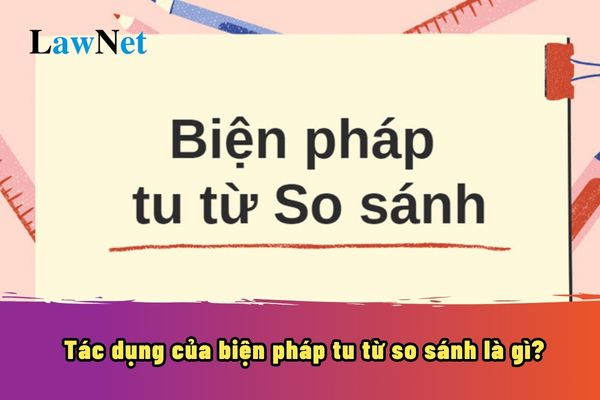What are the effects of the rhetorical device of comparison and examples of the rhetorical device of comparison? What is the grade at which students in Vietnam will initially learn the rhetorical device of comparison?
What are the effects of the rhetorical device of comparison and examples of the rhetorical device of comparison?
Students can refer to the following information on the effects of the rhetorical device of comparison and examples of the rhetorical device of comparison:
|
What are the effects of the rhetorical device of comparison and examples of the rhetorical device of comparison?
|
Note: Information is for reference only./.

What are the effects of the rhetorical device of comparison and examples of the rhetorical device of comparison? What is the grade at which students in Vietnam will initially learn the rhetorical device of comparison? (Image from the Internet)
What is the grade at which students in Vietnam will initially learn the rhetorical device of comparison?
Under Section 4 of the General Education Program for Literature issued with Circular 32/2018/TT-BGDDT stipulating the required outcomes:
REQUIRED OUTCOMES
1. Required outcomes for essential qualities and general competencies
The Literature subject contributes to developing in students the essential qualities and general competencies at levels suitable for the subject and educational level defined in the Overall Program.
2. Required outcomes for specific competencies
2.1. Required outcomes at the elementary level
...
b) Literary competency
...
For students in grades 3, 4, and 5: they should know how to expressively read literary texts; retell, summarize the main content of stories, poems; evaluate characters, events, and the writer's attitude and emotions in the text; recognize time and place, some types of poetic rhyme, rhythm, words, beautiful and unique images, and the effects of rhetorical devices like personification and comparison. Understand the meaning or lesson learned from the text. Write paragraphs or narrative and descriptive essays expressing feelings and imaginative abilities.
Thus, 3rd-grade students will initially learn the usage, recognition, and effects of the rhetorical device of comparison.
What are the methods of reading teaching for the 3rd-grade Vietnamese Language curriculum?
Under sub-section 3, Section 6 of the General Education Program for Literature issued with Circular 32/2018/TT-BGDDT, the regulation on teaching reading for primary school students in the Vietnamese language subject is as follows:
(1) Teaching reading comprehension of texts in general
Require students to read the entire text directly, paying attention to observing the formal elements of the text, thereby developing a general impression and summarizing the main content of the text;
Organize for students to search, discover, analyze, and infer the meaning of information, messages, opinions, attitudes, thoughts, emotions, etc., conveyed in the text; guide students to relate and compare among texts, connect the text with historical, cultural, and social contexts, connect the text with students' personal experiences, etc., to understand more deeply the value of the text, know how to apply and transform those values into personal beliefs and behavior in daily life.
(2) Teaching reading comprehension of literary texts: Literary text is also a type of text, so teaching reading comprehension of literary text should comply with the general text reading comprehension method.
However, literary texts have their own characteristics, so teachers should organize for students to explore and decode literary texts according to a process suited to the characteristics of artistic text.
Students need to be guided to practice reading literary works using a process that goes from recognizing the verbal text to exploring artistic imagery and seeking and concluding the content meaning; skills in identifying and interpreting the relationship between the "whole" and "part" of the text, discovering the integrity, unity of content, and perfection of form of literary works.
The teaching method should focus on activating positive, creative reading in the reader.
Guide and encourage students to proactively...

